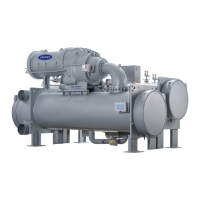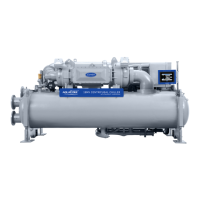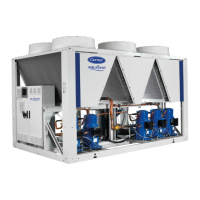49
Event States —
An event state is a specific set of condi-
tions that the controller may encounter when controlling the
chiller. Event states are repeatable, predictable, and represent
known states of the control. When the control is in a particular
state, a unique message is associated with that state. The event
state messages are displayed on the default screen of the con-
trol panel and are listed in Table 19.
Table 19 — Event States
TOUCH SCREEN SETTINGS
FOR THE CONTROLLER
The Setup screen is accessible only from the controller
touch screen, and is not password-protected by default. To ac-
cess the Setup display, press anywhere on the screen (except on
buttons or text fields) for 4 seconds. The Setup screen is dis-
played. See Fig. 57.
Unit IP Address —
On the Setup screen, press Network
to display the network parameters. See Fig. 58.
If “Enable DHCP” is checked the PIC 5 will attempt to
automatically populate IP settings from Dynamic Host Con-
figuration Protocol (DHCP) server.
NOTE: You must request an IP address, the subnet mask,
and the default gateway from the system administrator
before connecting the unit to the local Ethernet network.
EVENT NO. DESCRIPTION
1 Chiller Off
2 Chiller Tripout
3 Pumpdown Lockout
4 Terminate Pumpdown Lockout
5 Guide Vane 1 Calibration
6 Quick Test in Progress
7 Ice Build Done
8 Ice Build In Progress
9 Free Cooling In Progress
10 Auto Restart Pending
11 Condenser Flush In Progress
13 Envelop Control Valve Calibration
20 Startup Inhibited — Loadshed in Effect
21 Prestart Check in Progress
22 Timeout — Delay to Start in XX Min
23 Recycle in Progress
24 Startup in Progress
25 Swift Restart In Progress
30 Ramp Loading — Temperature
31 Ramp Loading — Motor Load
32 Ramp Loading — Capacity Inhibit
39 Demand Limit — Capacity Inhibit
40 Demand Limit — Capacity Decrease
41 Demand Limit — Inhibit Clamp
45 Override — High Condenser Pressure
47 Override — High Motor Temperature
48 Override — Low Evap Refrig Temp
50 Override — High Bearing Temp
51 Override — Low Discharge Superheat
52 Override — Manual VFD Speed Target
53 Override — High Motor Current
54 Override — High Discharge Temp
55 Override — Low Source Temp
60 Running — Temp Reset by 4-20 mA Signal
61 Running — Temp Reset by Remote Temp Sensor
62 Running — Temp Reset by Water DT
63 Running — Cooling Leaving Chilled Water
64 Running — Cooling Entering Chilled Water
65 Running — Heating Leaving Cond Water
66 Running — Heating Entering Cond Water
67 Envelop Control — Surge Correction
68 Envelop Control — Acts Before Recycle Shutdown
69 Envelop Control — Low Load Application
70 Envelop Control — Forced
71 Running — VFD Rampdown
72 Running — Guide Vane Position Forced
73 Running — VFD Speed Forced
74 Surge Prevention — Low
75 Surge Prevention — High
76 Surge Protection
77 Running - VFD Overcurrent
79 Running - Damper Valve Forced
80 Operation - Oil EXV Forced
81 Running - Head Pressure Valve Forced
85 Running - Vapor Source Valve Forced
90 Shutdown — Normal
91 Shutdown — Alarm
93 Shutdown — Recycle
94 Shutdown — Recycle Ice Build
95 Shutdown — Compressor Deenergized
96 Shutdown - Emergency Stop
97 Transducer Calibration in Effect
98 ISM Calibration in Effect
Network
Web Connection
System
Display
Keyboard
Password
Language
1
2
3
4
5
6
7
Back to application
8
Setup
LEGEND
1—Network: System properties for Ethernet interface
2—Web Connection: Configuration for web-based welcome
page
3—System: Software version, buzzer
4—Display: Settings such as contrast, backlighting
5—Keyboard: Not applicable
6—Password: For "Setup" access
7—Language: For "Setup" only
8—Return to application
Fig. 57 — Setup Screen
LEGEND
1—Enable DHCP
2—IP address
3—Subnet mask
4—Default gateway
5—Primary DNS Server
6—Secondary DNS Server
Fig. 58 — Network Screen

